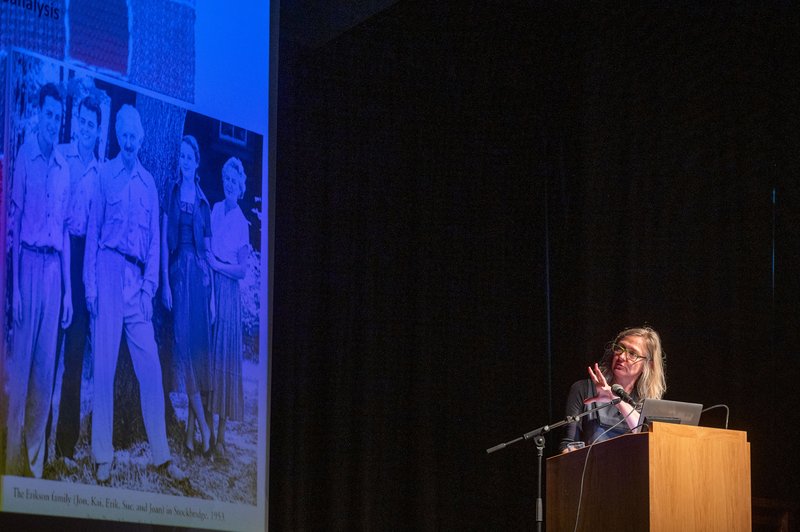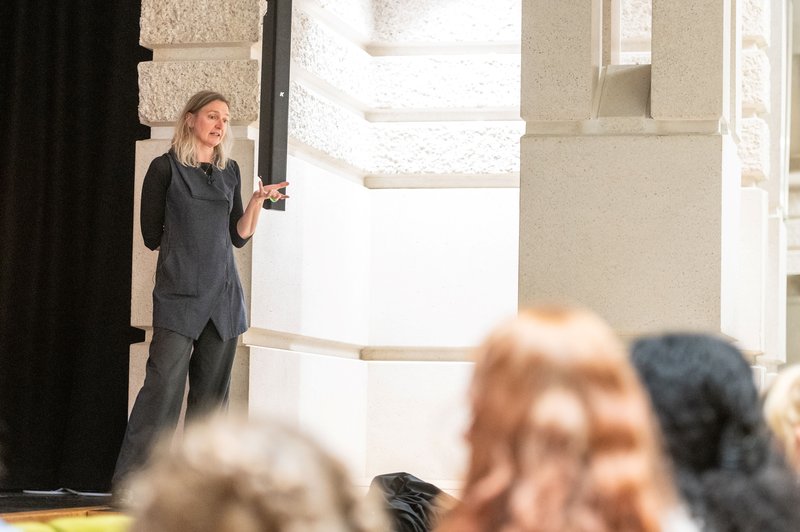Founder's Lecture 2025
Since the 1980s, feminist thinkers have turned to the concept of ‘care’ to identify the often invisible work done by women, whether in the home or in the care industry. But what about before?
To explore this question, Professor Sarah Knott turned to the United States of the 1950s. A fascinating hybrid of intellectual and kitchen-table history, her lecture told the story of ‘care’ as conceptualised by the psychoanalyst, Erik Erikson, and his wife, Joan. By examining two particularly curious artefacts produced by the Erikson family, Professor Knott uncovered the academic and cultural significance of care in the decades before caregiving and domestic labour emerged as topics of women’s liberation.

Professor Knott began with a black and white diagram of Erik Erikson’s eight-stage model of psychosocial development. First published in Childhood and Society (1950), Erikson’s model expanded upon the Freudian psychosexual theory of human development to encompass the years of life after early childhood, describing for the first time the crises of adolescence and middle age. Erikson proposed that the characteristic crisis of mid-life was one of generativity versus stagnation: of needing to be needed by one’s community. Strikingly, Erikson defined the product of this mid-life crisis as ‘care’. As Professor Knott explained, Erikson used this term in a very particular manner, that is, in accordance with its Latin etymon, caritas (charity). For Erikson, care was the human strength of stewardship, an avuncular response to the fear borne of a loss of usefulness.
As the second part of Professor Knott’s lecture made clear, for all its universal claims, Erikson's was unwittingly a male model of development. The conceptualisation of care in particular largely erased the kinds of hands-on, labour-intensive caregiving performed in the home, typically by women. This invisibilization has of course had a lengthy undertow.
The masculinist bias of Erik Erikson’s model and its narrow understanding of care was all the more striking, Professor Knott explained, by the significant contributions of Joan Erikson to the development of the model. An arts therapist, it was Joan who first identified the necessity of characterising the psychosocial crisis of middle life. Yet as her husband’s academic celebrity grew and his model became a cultural phenomenon, Joan’s contributions were slowly erased. Meanwhile, as described in her daughter’s memoirs, Joan was left to try and compensate for the care deficit in the Erikson household caused by Erik’s absence.
By returning us to the cultural moment at which care first emerged as an academic concept in the 1950s, Professor Knott demonstrated that the simultaneous erasure of domestic caregiving from intellectual discourse and of Joan Erikson’s contributions to the analysis of psychosocial development represent two sides of the same coin. By re-centering the intellectual history of care on women carers and theorists alike, the lecture made a compelling case for a feminist history of care: one that we very much hope that Professor Knott will go on to write.

Following the lecture, Professor Knott fielded questions from graduate students, Fellows, alumni, and even collaborators working elsewhere in the University on the intellectual history of ‘care’. Questions ranged widely from the role of the school in Erikson’s theory of mid-childhood development to Erikson’s responses to feminist critique in the last decades of his life.
We are grateful to Professor Knott for such an interesting lecture and to all attendees for offering such thoughtful responses.